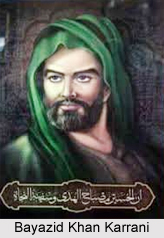 Sulaiman Khan Karrani was a ruler of Bengal since the death of his elder brother Taj Khan Karrani of Karrani dynasty. According to the Riyaz-us-Salatin, he shifted the seat of government from Gaur now in Malda District of West Bengal to Tanda.
Sulaiman Khan Karrani was a ruler of Bengal since the death of his elder brother Taj Khan Karrani of Karrani dynasty. According to the Riyaz-us-Salatin, he shifted the seat of government from Gaur now in Malda District of West Bengal to Tanda.
Rule of Sulaiman Khan Karrani
Sulaiman Khan Karrani and his brother Taj and Sulaiman`s sons Bayazid Khan Karrani and Daud Khan Karrani ran a short-lived Afghan vassal state of Mughal emperor Akbar in Bengal. They dominated the area while Sulaiman paid homage to Akbar. The Afghans defeated by Akbar began to flock under his flag. The Afghans were not technically the rulers of Bengal, the post was primarily nominal.
Relation with Mughal Emperor Akbar and Sulaiman Khan Karrani
Sulaiman Khan Karrani did not establish his own coinage during his reign, an act that would have been tantamount to declaring statehood to the ruling Mughal Empire in India. Sulaiman Khan Karrani also honoured Emperor Akbar as the supreme ruler of Bengal by requiring that mosques read Akbar`s name in the Khutbah, the sermon at the Friday congregational prayers in Bengal. The Bengal historians cite that these acts are known to keep the diplomatic peace between Bengal and Mughal Empire during Akbar`s lifetime.
Conquest by Sulaiman Khan Karrani
Though northern India and parts of southern India were ruled by the Muslim rulers, they had not yet been able to conquer Odisha. In 1568 Sulaiman Khan sent his son Bayazid Khan Karrani and the famous general Kala Pahar against the last Oriya Gajapati king Mukunda Deva. After a few major battles against the Oriyas, and aided by civil war elsewhere in Odisha, Sulaiman was able to bring the entire area under his rule. Kalapahar sacked the Jagannath temple and took Puri under control. Sulaiman Karrani appointed Lodi Khan and Qutlu Khan Lohani governors of Odisha and Puri respectively.
Conquest of Cooch Behar
Sulaiman Khan Karrani then sent General Kala Pahar against the Kamata king Vishwa Singha. Kala Pahar crossed the Brahmaputra River and advanced as far as Tejpur. Kala Pahar defeated and captured the Kamata general Shukladhwaja, third son of Bishwa Singha.
Death of Sulaiman Khan Karrani
Sulaiman Karrani died on 11th October 1572, leaving his empire to his son, Bayazid Khan Karrani.
Related Articles
West Bengal
History of West Bengal
Medieval History of Bengal
Nawabs Of Bengal
Ancient History of Bengal
Najimuddin Ali Khan
Bengal Subah in Medieval History
Revenue Policy of Mughals in Bengal
Tax System under Mughals in Bengal



















